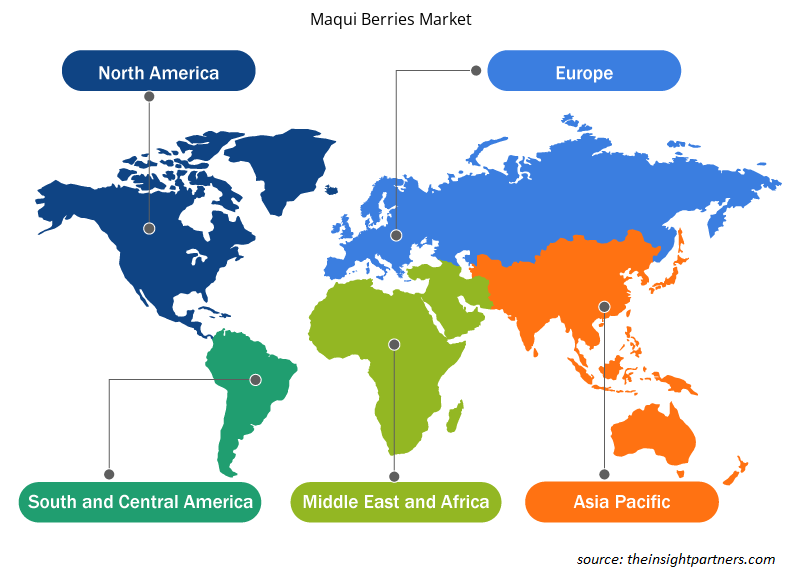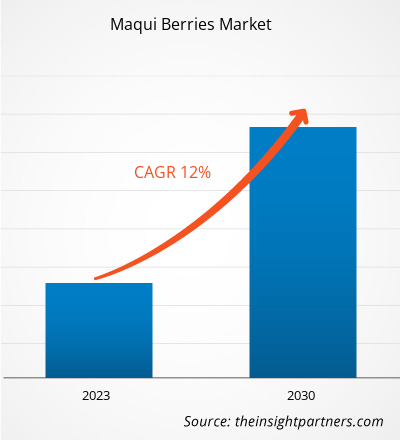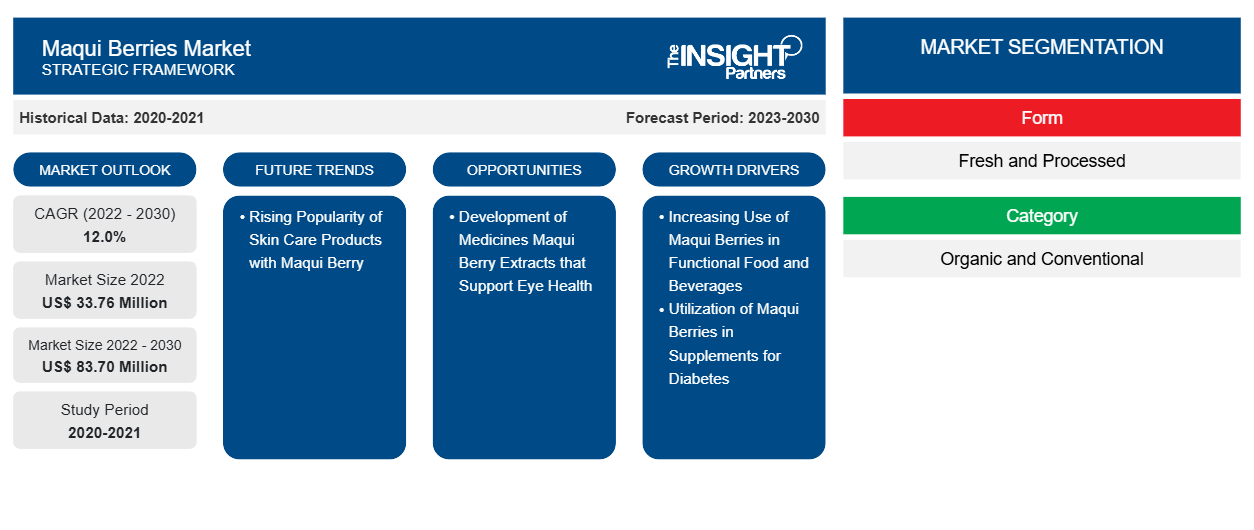[Informe de investigación] Se espera que el mercado de bayas de maqui crezca de US$ 33,76 millones en 2022 a US$ 83,70 millones en 2030; se espera que registre una CAGR del 12,0% de 2022 a 2030.
Perspectivas del mercado y opinión de analistas:
La tendencia emergente de productos orgánicos y de etiqueta limpia en alimentos y bebidas funcionales, cosméticos, suplementos nutricionales y cuidado personal ha creado oportunidades lucrativas para los participantes clave de la industria. Las bayas de maqui también han impulsado el crecimiento en la industria del cuidado personal, con empresas que sustituyen las bayas de acai y otros extractos exóticos como ingrediente en sus productos con bayas de maqui antioxidantes, que muestran propiedades antienvejecimiento excepcionales. La creciente popularidad y expansión del comercio electrónico permite a los actores clave ofrecer productos en línea a precios razonables. Los consumidores están tomando conciencia de los beneficios para la salud de las bayas de maqui, lo que impulsa la demanda de productos a base de bayas de maqui. Todos los factores aumentan aún más la demanda de bayas de maqui.
Personalice este informe según sus necesidades
Obtendrá personalización en cualquier informe, sin cargo, incluidas partes de este informe o análisis a nivel de país, paquete de datos de Excel, así como también grandes ofertas y descuentos para empresas emergentes y universidades.
-
Obtenga las principales tendencias clave del mercado de este informe.Esta muestra GRATUITA incluirá análisis de datos, desde tendencias del mercado hasta estimaciones y pronósticos.
Factores impulsores del crecimiento y desafíos:
En los últimos años, la prevalencia de la diabetes ha aumentado significativamente debido a la falta de actividad física, el aumento del consumo de comida chatarra, la creciente prevalencia de la obesidad y el estilo de vida estresante de los consumidores. Según el Informe Nacional de Estadísticas de Diabetes de 2022, 37,3 millones de personas en los EE. UU. Tenían diabetes en 2022, lo que representa el 11,3% de la población total de EE. UU. La diabetes puede provocar graves problemas de salud, como ataques cardíacos y accidentes cerebrovasculares, pérdida de la visión y enfermedades renales, si no se trata y controla a tiempo. Se han descubierto muchos tratamientos y medicamentos para la diabetes. Sin embargo, los científicos todavía están trabajando para encontrar remedios naturales con alta eficacia para curar la diabetes y regular el nivel de azúcar en sangre. Las bayas de maqui son ricas en antocianinas, polifenoles y delfinidina que ayudan a neutralizar los radicales libres, estimular la inmunidad, prevenir el cáncer y reducir el exceso de azúcar en sangre. Las bayas de maqui son las fuentes más ricas de antocianinas con un 25% de composición de cianidinas y un 75% de delfinidina. Comprenden el mayor contenido de delfinidina entre todas las bayas.
Contenido de delfinidina en las bayas de las “superfrutas”
|
Sr. No.
|
Superfruta
(Nombre común/Nombre botánico)
|
Contenido de delfinidina
(en mg/100 g de fruta cruda)
|
|
1 |
Baya de Maqui/Aristotelia chilensis |
126,00 |
|
2 |
Arándano/Vaccinium myrtillus |
97,59 |
|
3 |
Uva Concord/Vitis vinifera |
70,62 |
|
4 |
Arándano cultivado/vaccinium spp. |
35.43 |
|
5 |
Aronia o Chockeberry/Aronia melanocarpa |
0,65 |
|
6 |
Açai/Euterpe oleraceae |
0 |
Fuente: Base de datos del Departamento de Agricultura de los Estados Unidos (USDA) para el contenido de flavonoides de alimentos seleccionados
La delfinidina se ha investigado ampliamente por sus efectos beneficiosos para la salud, uno de los cuales es la reducción de la glucemia posprandial en personas con alteración de la regulación de la glucosa. El delphinol, un extracto estandarizado de bayas de maqui producido por Anklam Extrakt GmbH, se ha estudiado para prevenir los picos de azúcar en sangre y curar la diabetes tipo 2 y otras complicaciones. En diciembre de 2022, MD Process lanzó GlucoBerry, una fórmula patentada basada en el extracto de bayas de maqui que ayuda a controlar el azúcar en sangre a través de sus efectos antioxidantes que ayudan al riñón a filtrar el azúcar del torrente sanguíneo. Este mecanismo también ayuda a que la insulina realice sus funciones de manera eficaz. Por lo tanto, existe una creciente demanda de bayas de maqui para desarrollar suplementos y medicamentos para la diabetes, lo que impulsa la
mercado de bayas de maqui
Segmentación y alcance del informe:
El “Mercado Global de Bayas de Maqui” está segmentado en función de la forma, categoría, aplicación y geografía. Según la forma, el mercado de las bayas de maqui se segmenta en frescas y procesadas. Por categoría, el mercado se bifurca en orgánico y convencional. Según la aplicación, el mercado de las bayas de maqui se segmenta en alimentos y bebidas funcionales, productos farmacéuticos y nutracéuticos, cuidado personal y cosméticos, y nutrición animal. El mercado de las bayas de maqui, según la geografía, está segmentado en América del Norte (Estados Unidos, Canadá y México), Europa (Alemania, Francia, Italia, el Reino Unido, Rusia y el resto de Europa), Asia Pacífico (Australia, China, Japón, India, Corea del Sur y el resto de Asia Pacífico), Oriente Medio y África (Sudáfrica, Arabia Saudita, los Emiratos Árabes Unidos y el resto de Oriente Medio y África), y América del Sur y Central (Brasil, Chile y el resto de América del Sur y Central).
Análisis segmental:
Según la forma, el mercado de las bayas de maqui se segmenta en frescas y procesadas. El segmento procesado tuvo una mayor participación en el mercado de las bayas de maqui en 2022 y se espera que registre una tasa de crecimiento significativa durante el período de pronóstico. Las bayas de maqui se procesan en diferentes formas, como congeladas, secas y en polvo, para aumentar su vida útil. Las bayas de maqui frescas están disponibles principalmente en países sudamericanos como Chile y Argentina. Sin embargo, las bayas de maqui frescas son altamente perecederas y están expuestas a daños durante el transporte, lo que genera desperdicios y altos costos de transporte. Por lo tanto, las industrias de uso final de las bayas de maqui generalmente prefieren las bayas procesadas para reducir el desperdicio y los enormes costos de transporte. Estos factores impulsan significativamente el crecimiento del mercado para el segmento procesado.
Análisis regional:
Según la geografía, el mercado de las bayas de maqui está segmentado en cinco regiones clave: América del Norte, Europa, Asia Pacífico, América del Sur y Central, y Oriente Medio y África. El mercado mundial de las bayas de maqui estaba dominado por América del Norte y se estimó que rondaría los 11 millones de dólares estadounidenses en 2022. Europa es el segundo contribuyente principal, con más del 25% de la participación del mercado. El mercado norteamericano de las bayas de maqui está segmentado en Estados Unidos, Canadá y México. América del Norte es uno de los principales mercados de las bayas de maqui debido a la creciente demanda de alimentos y bebidas ricos en antioxidantes. Las bayas de maqui tienen el mayor contenido de antioxidantes que los arándanos, las bayas de acai y las bayas de goji. Los antioxidantes ayudan a reducir el riesgo de enfermedades crónicas, como el cáncer, las enfermedades cardíacas y la diabetes. Además, ralentizan el proceso de envejecimiento, promueven un intestino sano y estimulan la inmunidad, proporcionando longevidad. Las crecientes preocupaciones por la salud debido a los estilos de vida agitados, la falta de actividad física y el aumento del consumo de comida chatarra impulsan la demanda de alimentos y bebidas funcionales en América del Norte. Además, la gente prefiere activamente los alimentos y bebidas con un alto contenido de antioxidantes naturales que aportan numerosos beneficios para la salud. Debido a estos beneficios, la demanda de bayas de maqui está aumentando en toda la industria de alimentos y bebidas en América del Norte.
Desarrollos industriales y oportunidades futuras:
A continuación se enumeran varias iniciativas adoptadas por los actores clave que operan en el mercado de las bayas de maqui:
- En agosto de 2023, CK Nutraceuticals, con sede en Canadá, amplió su acuerdo de distribución en América del Norte con Maqui New Life, con sede en Chile, para la promoción y distribución de los ingredientes Delphinol y MaquiBright derivados de la baya de maqui.
Perspectivas regionales del mercado de bayas de maqui
Los analistas de Insight Partners explicaron en detalle las tendencias y los factores regionales que influyen en el mercado de bayas de maqui durante el período de pronóstico. Esta sección también analiza los segmentos y la geografía del mercado de bayas de maqui en América del Norte, Europa, Asia Pacífico, Oriente Medio y África, y América del Sur y Central.

- Obtenga los datos regionales específicos para el mercado de bayas de maqui
Alcance del informe sobre el mercado de bayas de maqui
| Atributo del informe | Detalles |
|---|---|
| Tamaño del mercado en 2022 | US$ 33,76 millones |
| Tamaño del mercado en 2030 | US$ 83,70 millones |
| CAGR global (2022-2030) | 12,0% |
| Datos históricos | 2020-2021 |
| Período de pronóstico | 2023-2030 |
| Segmentos cubiertos |
Por formulario
|
| Regiones y países cubiertos |
América del norte
|
| Líderes del mercado y perfiles de empresas clave |
|
Densidad de actores del mercado de bayas de maqui: comprensión de su impacto en la dinámica empresarial
El mercado de las bayas de maqui está creciendo rápidamente, impulsado por la creciente demanda de los usuarios finales debido a factores como la evolución de las preferencias de los consumidores, los avances tecnológicos y una mayor conciencia de los beneficios del producto. A medida que aumenta la demanda, las empresas amplían sus ofertas, innovan para satisfacer las necesidades de los consumidores y aprovechan las tendencias emergentes, lo que impulsa aún más el crecimiento del mercado.
La densidad de actores del mercado se refiere a la distribución de las empresas o firmas que operan dentro de un mercado o industria en particular. Indica cuántos competidores (actores del mercado) están presentes en un espacio de mercado determinado en relación con su tamaño o valor total de mercado.
Las principales empresas que operan en el mercado de bayas de maqui son:
- Corporación de ingredientes HP.
- Compañía de biotecnología Shaanxi LonierHerb Bio-Technology Ltd.
- Suministros de la selva tropical LLC
- Ingredientes CK Inc.
- Jeeva Organic Pvt Ltd
Descargo de responsabilidad : Las empresas enumeradas anteriormente no están clasificadas en ningún orden particular.

- Obtenga una descripción general de los principales actores clave del mercado de bayas de maqui
Impacto del COVID-19:
El brote de COVID-19 alteró significativamente las cadenas de suministro agrícola. Los cierres, las prohibiciones comerciales y las restricciones fronterizas obstaculizaron la producción y el suministro de materias primas como las bayas de maqui frescas y secas en todo el mundo. El rendimiento agrícola se redujo significativamente debido a las restricciones de cierre, la escasez de mano de obra y el cierre de negocios a nivel nacional. Inicialmente, en 2020, los consumidores comenzaron a comprar de pánico debido al miedo al cierre, lo que creó una escasez masiva de bayas de maqui. Además, como se prohibió el comercio internacional, el volumen de importación de frutas exóticas como las bayas de maqui también disminuyó, lo que creó una escasez de oferta. Este factor también resultó en aumentos de precios, lo que obstaculizó las ventas de varios fabricantes de frutas exóticas que operan en el mundo.
Muchas empresas se recuperaron a medida que los gobiernos de varios países suavizaron las restricciones después de los meses iniciales de confinamiento en 2020. La introducción de la vacuna COVID-19 ofreció un mayor alivio a la angustiosa situación de la pandemia, lo que llevó a un aumento de las actividades comerciales. La reanudación de las operaciones en las unidades de fabricación tuvo un impacto positivo en el mercado de las bayas de maqui en el mundo. Los fabricantes superaron la brecha de oferta y demanda, ya que se les permitió operar a plena capacidad. Además, las iniciativas estratégicas adoptadas por los actores clave impulsan la demanda de las bayas de maqui. Por ejemplo, en agosto de 2023, CK Nutraceuticals, con sede en Canadá, amplió su acuerdo de distribución en América del Norte con Maqui New Life, con sede en Chile, para la promoción y distribución de los ingredientes Delphinol y MaquiBright derivados de las bayas de maqui.
Panorama competitivo y empresas clave:
HP Ingredients Corp, Shaanxi LonierHerb Bio-Technology Co Ltd, Rainforest Supply LLC, CK Ingredients Inc, Jeeva Organic Pvt Ltd, Ferreiro & Co Inc, Abbott Blackstone Co, Vita Forte Inc, Nature's Power Nutraceuticals Corp y Xi'an Herb Bio-Tech Co Ltd se encuentran entre los actores destacados que operan en el mercado global de bayas de maqui. Estos fabricantes de bayas de maqui ofrecen productos de vanguardia a base de bayas de maqui con características innovadoras para brindar una experiencia superior a los consumidores.
- Análisis histórico (2 años), año base, pronóstico (7 años) con CAGR
- Análisis PEST y FODA
- Tamaño del mercado, valor/volumen: global, regional y nacional
- Industria y panorama competitivo
- Conjunto de datos de Excel
Informes recientes
Testimonios
Razón para comprar
- Toma de decisiones informada
- Comprensión de la dinámica del mercado
- Análisis competitivo
- Información sobre clientes
- Pronósticos del mercado
- Mitigación de riesgos
- Planificación estratégica
- Justificación de la inversión
- Identificación de mercados emergentes
- Mejora de las estrategias de marketing
- Impulso de la eficiencia operativa
- Alineación con las tendencias regulatorias























 Obtenga una muestra gratuita para - Mercado de bayas de maqui
Obtenga una muestra gratuita para - Mercado de bayas de maqui